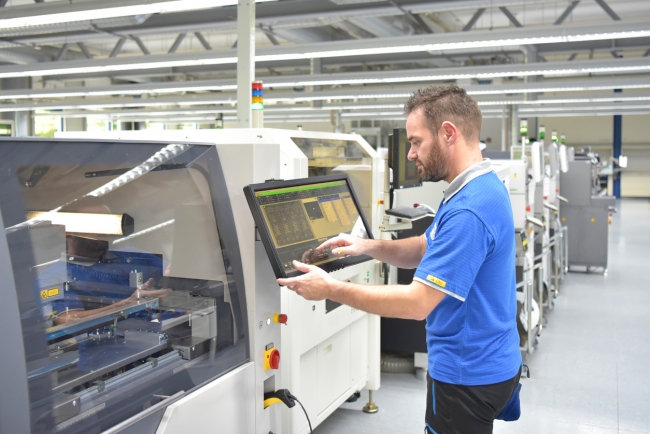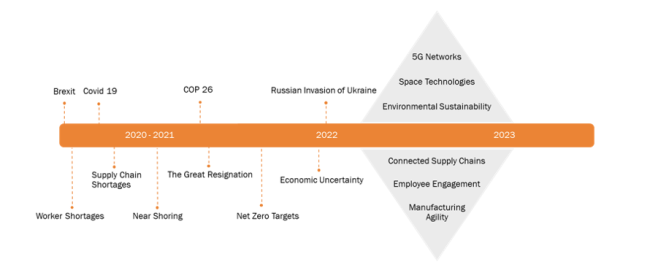5 minute read • published in partnership with ATS
Insight: The importance of agility to adapt manufacturing processes and supply chains
Agility can be defined as the ability to adapt to changing situations easily. The goal of agile manufacturing is to quickly respond to customer and market demands to take advantage of small windows of opportunity in rapidly changing markets, or to be able to adapt and flex to challenges within our manufacturing environment or supply chain. Mike Smith from ATS shares his thoughts on what manufacturers should focus on.
We are going to have a look into what agility is and how we can apply this to the manufacturing domain to enable manufacturers to stay relevant, adapt, compete, and fundamentally remain competitive in our ever-changing world.
When looking back over the last few years, it can be seen that there have been many unexpected events that have massively impacted manufacturers, which is often in a negative way. The Covid-19 pandemic is a prime example of a situation that caused a huge shift in our world. It was and is a massive time of change that impacted all kinds of manufacturing and continues to impact, such as: supply chain, workforce, demand, health and safety changes, remote working etc. The companies that have survived and even thrived are the ones that have been able to quickly pivot, the ones that have adapted to new products, changed their processes, and adapted to their supply chains.

The goal of agile manufacturing is to quickly respond to customer and market demands and adapt and flex to challenges within our manufacturing environment or supply chain / Picture: Getty/iStock
In order to adapt to changing situations, we must first start with being able to see what is changing. This can take many forms depending on what our focus is. Let us take the supply chain as an example. In order to react to its disruptions, we need to have connectivity and visibility – the capability to understand when our suppliers will deliver, if they are encountering any delays and if the order will be delivered in full of the grade or quality that is required. Once we have that information it can then be fed into your enterprise resource planning and scheduling systems to understand the impact that it is going to have on your output before adapting accordingly to change your plan or perhaps procure components for alternative suppliers.

Key disruption timeline of the last three years / Graphic: ATS
To break this down further, the stages of agility can be viewed as three stages: connect, understand and adapt. Every stage is critical to making intelligent decisions and these can be applied to all domains when looking at manufacturing agility. The foundational principle of agility is to make the required changes rapidly. A change made too late can be more harmful than not changing at all.
Connect
Connection is required to capture the information that we need in order to react. That connection will differ depending on the area of focus. For the supply chain an example would be connectivity to the suppliers enterprise resource planning tool or could be a customer link to your ERP tool. Alternatively, a customer portal application where that they can input data into. Another example of agility may be the ability to react and adapt to what is going on in your own manufacturing environment. For this example, connectivity would be to the machines and processes on the shop floor collecting the machine status, throughput and quality metrics.
Understand
Understanding or Analysis could take different forms depending on the data. It could be as simple as consuming the supplier data into an automated schedule to forecast what the effect could be. It could be a case of running machine data into visual dashboards to enable the shift manager to understand the production process in real time or it could take the form of taking the data that you have captured in the connection stage and pushing it to an analytics platform to better understand the trends and impacts that they are having. Understanding the data will require your input as the expert on your own manufacturing processes and data and the appropriate tools for the required analysis.
Adapt
The adaption phase is often what we look for and understand as agility – a company that is rapidly changing is often seen as agile. But without the foundation of the previous two stages, it could be argued that it is just erratic. Once you understand what impact changes are having you can then truly adapt to them for positive benefit. These changes could be de-risked with simulation as a final check. Armed with the data and its understanding you should then be able to modify your manufacturing based on your goals and the market demands. Some simple examples would be to scale down your production rate of a product as demand drops off or to change to an alternative supplier when experiencing supply chain issues. Again, this is a phase where the connection phase brings its benefits as you can rapidly enact the change through connected systems. Whether that is via a manufacturing operations management system as a higher-level control of manufacturing or an IOT system to change a machine setpoint based on different material specs.
I would suggest that we all start looking at how we can have better understanding of the “black box” that is often our manufacturing processes and supply chains so that we can flex and adapt to the changes that continue to impact our success as manufacturers so that we can react and thrive. This is an area where ATS have numerous amount of experience and would be able to assist with.
